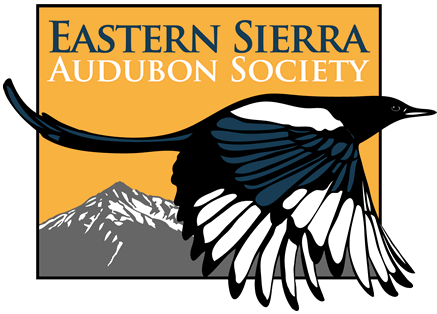[Originally appeared in the Sierra Wave newsletter, Vol. 25, No. 1, Sept-Oct 2006 – click here for original with photos]
On 31 July, Eva Poole-Gilson looked at her bird feeders, as she often does, and saw a large yellow and black bird that was different from the other feathered visitors at her home in Keoughs Hot Springs. She called her next-door neighbor, Cindy Kamler, our Eastern Sierra wildlife rehab specialist, who looked at the bird and knew that it was really different. Cindy went through her bird books and found a bird that looked very similar. She called us and said that she believed she had a Yellow Grosbeak at her neighbors feeder. When asked if she knew how unexpected that would be, she said, Yes I do! It is not supposed to be found in the US!

Yellow Grosbeak, Photo by Bob Steele
Yellow Grosbeak is primarily a Mexican species that resides along the Pacific Slope from southern Sonora to northwestern Oaxaca plus a disjunct population in Guatemala. In summer (Mar-Sep) birds from the northern population move north to central Sonora and occasionally one forgets to stop and ends up in the U.S. Most of the few U.S. records are from Arizona, usually in the southern part, with the earliest arrival June 4th and the latest August 12th. A male spent the winter, 2005-2006, in Albuquerque, New Mexico and because it remained through May the report has not yet been ruled on by the State Bird Records Committee. A report of a wintering bird in Iowa was not accepted as a state record because it was felt it was an escaped caged bird and did not get there without human help.
Because of the male Yellow Grosbeak who wintered in New Mexico this year, many wondered if the Inyo bird could be one and the same. Curiously, both birds had deformed bills, that is, the upper mandible was shorter than the lower. But a search of the web turned up many pictures of the New Mexico bird. The right side of the bill was different from the Inyo bird and the plumages were different suggesting that these were different birds. See the Eastern Sierra Birds website for comparison photos.
The Yellow Grosbeak remained at Keoughs Hot Springs through August 2nd allowing 50-60 people to look, photograph, and marvel at this stunning bird. To determine if this sighting becomes a record, documentation and photographs must be submitted to the California Bird Records Committee for review. No one will question if the identification was wrong because this was an easy call. What must be determined is the origin of the bird. Did it get to Inyo County under its own power or was it a caged bird that was transported from somewhere in Mexico to the U.S. or along the Mexican border and escaped?
There are a number of factors that need to be explored. First is the abnormal plumage the bird was wearing. It had the black wings and tail of an adult combined with immature body feathers that included a white belly, instead of yellow, and a black back, instead of yellow, as well as a gray halo on its crown. Can this occur naturally or is it the result of captivity stress?
Second is the abnormal bill with an under-bite and the inability to close the bill completely. Bill abnormalities occur naturally, but can they be caused by captivity? Third is that captivity can cause extreme feather wear as a result of being kept in too small a cage and nail length can increase because of the less abrasive nature of cages. That said, one molt and a period of freedom will erase those indications of previous captivity.
Fourth is our distance from bird shops that might sell this species. It is illegal to sell Yellow Grosbeaks in the U.S. so the nearest source should be just south of the California-Mexico border. The fifth consideration is the timing. Based on the pattern indicated by Arizona vagrants, this is exactly the time one could appear here if this was a natural occurrence.
And lastly, there is a suite of primarily Mexican species that have already made it to Inyo County under their own power (Rufous-backed Robin, Streak-backed Oriole, Thick-billed Kingbird, Northern Caracara, Broad-billed Hummingbird, Dusky-capped Flycatcher, Tropical Kingbird, Painted Redstart, Red-faced Warbler, Varied Bunting, and Bronzed Cowbird). Is this just another who followed in the same wing beats as his predecessors?
If accepted as a natural vagrant it will be the first record of a Yellow Grosbeak for California. The decision will not be an easy one but CBRC members are used to unraveling this kind of conundrum.
Tags: crow, flycatcher, grosbeak, hummingbird, kingbird, oriole, robin, warbler
